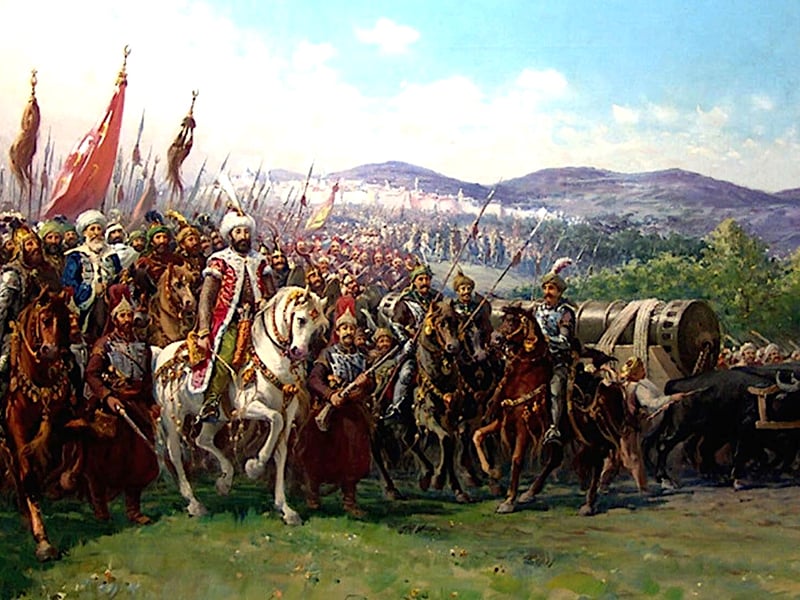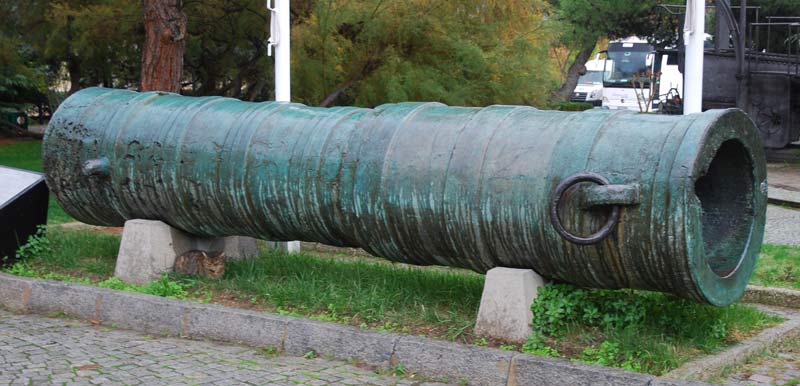As a day in history, few outside of modern Turkey are likely to note the significance of May 29, 1453. In fact, the date has only seen renewed interest among the Turkish people under the leadership of President Recep Tayyip Erdoğan. To historians, the day is often considered to mark the end of the Middle Ages and the beginning of the Renaissance — as it marks the final end of the Byzantine or Eastern Roman Empire with the fall of Constantinople to the Ottoman Turks.
In the 570 years since that event, the significance of cannons in the nearly two-month-long siege has been noted, but some historians have argued that is overstated.

The Age of Gunpowder
Although gunpowder was invented in China in the second or third centuries, it wasn’t until the Late Middle Ages that European armies employed weapons such as cannons on the battlefield. English cannons were first recorded in 1327 and saw more general use during the Hundred Years’ War with France, with primitive cannons employed at the Battle of Crécy in 1346. In that particular battle, however, the English longbow probably played a more significant role.
Far from the fields of Northern France, medium cannons were also being employed by the forces of the Byzantine Empire. These were as long as three feet long and had a 10-inch bore. It has been suggested that these weapons were used to reasonable success to fend off the Ottoman invaders — but the centuries-old empire was on its last legs. The inheritors to the Roman Empire, the Byzantine Empire by the middle of the 15th century was reduced to little more than the once glorious city of Constantinople.
Yet its massive walls had largely defended the capital city for centuries — although treachery in the early 13th century led to its brief capture by the last of the European Crusader knights who founded the short-lived Latin Empire. Black Death had also killed almost half the city’s population in the 14th century, just decades later, it was little more than walled villages encircled by the fifth-century Theodosian Walls. Yet, thanks to those walls — which had been steadily improved over the millennia — Constantinople was essentially a seemingly impenetrable fortress that could withstand any siege.

Ottoman Siege Guns
Seeing how cannons had successfully fended off invaders, the Ottoman Turks began to construct their own massive guns, which were used to break the eight-year-long siege of Thessalonica in 1430.
In 1451, Mehmed II succeeded his father as Sultan of the Ottomans. He was just 19 years old, and many across the courts of Europe thought the inexperienced young man would lead the Ottomans astray. They were wrong, and he set out to do what his father and other Turkish rulers before had failed to do — take the once majestic imperial city of Constantinople as his own.
Of course, the walls were an issue; yet, cannons seemed to be the answer. At least according to the common story, a Hungarian cannon founder by the name of Orban arrived at the Imperial Court of Byzantine Emperor Constantine XI with the promise to help build powerful guns.

According to the often-told tale, Constantine was certainly interested in Orban’s offer to produce cannons but didn’t have the funds to keep the founder on the payroll. Instead, the Hungarian ventured to Edirne, the then-capital of the Ottoman Empire — where Orban offered his services to Mehmed II.
During the autumn of 1452, Orban set to work casting one of the largest cannons ever built. Orban made the bold promise that it could shatter the walls of Constantinople to dust. The gun was reported to be 27 feet long, with a bore that was 30 inches, while the barrel was walled with eight inches to absorb the force of the blast. It could fire a shot weighing upwards of half a ton.
The massive cannon, which weighed 16.8 tons, had a range of 1.5 miles — longer than any weapon of the era. 200 men, along with 60 oxen were detailed for transporting the gun the 140 miles to Constantinople. Dozens of carpenters and hundreds of other artisans were charged with strengthening the road to allow for the gun’s transport.
Moreover, it was just one of the dozens of guns that Orban’s foundry produced for the siege. Though none was as large as the massive weapon, some were still more than 14 feet long. In total, some 70 cannons were used in the siege — the largest number employed to that point in history.
Yet, modern historians dismiss the actual role that the bombard cannons actually played in the siege. It wasn’t the guns; it was the number of fighters on each side that resulted in the Ottoman victory. Mehmed II had a huge force of some 80,000 men, including Janissaries, archers, and infantry; while Constantine XI had fewer than 10,000 professional soldiers, bolstered by around 30,000 armed civilians.

“Artillery certainly materially contributed to the final victory, but it has to be seen in the context of other factors, including the tiny size of the Constantinopolitan garrison relative to the Ottoman army and the effectiveness of the Ottoman blockade of the city,” explained Dr. John F. Haldon, professor of history and Hellenic studies at Princeton University.
The siege lasted one month, three weeks, and two days, ending on May 29, 1453. Turkish losses were high, with at least 15,000 killed, while some reports suggested as many as 50,000 died taking the city. The Byzantine dead numbered nearly 5,000 including Constantine XI, whose body was never found.
Mehmed II granted his soldiers three days to plunder the city, and most of the population of some 30,000 civilians was enslaved. The Ottoman Sultan is now remembered as Mehmed the Conqueror.
Myths of History — The Big Guns
There is no denying that the Ottomans had been early adopters of artillery, using cannons as in the Battle of Kosovo in 1389, in the Battle of Nukap in 1396, and in the Second Battle of Kosovo in 1448. It is also true that Orban did construct massive guns for the Turks.
Yet, as noted, it was the number of Ottoman troops, not the big guns that played such a significant role in the siege.
“There is a modern Turkish triumphalist narrative on the role of the canon created by Orban, which I think is where the idea of the ‘first artillery barrage’ may come from,” said Dr. Maria Mavroudi, professor of history specializing in Byzantine and Islamic sciences at the University of California Berkeley.
She noted that gunpowder cannons were already well-known in China since the 12th century and in Europe since the 13th century. The past narratives have just overstated the role that the cannons played in the siege.
“Orban’s cannon is mentioned in Laonikos Chalkokondyles, but the modern triumphalist Turkish narrative does not come out of the 15th-century sources,” added Mavroudi. “The cannon is emphasized in Turkish modernity because embracing the latest technology is a sign of an early Ottoman passage into modernity. This counters the portrayal of the Ottoman Empire as behind European modernity and as the ‘sick man of Europe’ — the widespread characterization of the Ottoman Empire in Europe during the 19th and early 20th centuries.”
Another factor is popular culture.
Just as movies and TV shows have colored our view of more recent history, so too have modern movies painted a misleading view of the Ottoman’s use of cannons in the siege.
“The importance of the cannon in the modern Turkish imaginary was largely fostered by Turkish B-movies on Byzantium,” said Mavroudi.
Other Ottoman Weapons
The vast majority of the Ottoman soldiers were not even gunners. Most still maintained a “medieval” look that included chainmail armor, swords, and shields.
The kilij — a type of cavalry saber — was the Ottoman variant of a Turko-Mongol sword that had originated in Central Asia. The single-handed, single-edged curved sword had also been carried by soldiers of the Seljuk Empire and the Mamluk Empire. It took on the shape most associated with the Ottoman Turks in the middle of the 15th century, coinciding with the reign of Mehmed the Conqueror.

The more common weapons of the era were the Turkish recurve bows — which were produced in three varieties, including the war (tirkeş), target (puta), and long-range (menzil) bows. All three types were generally made of four materials that included wood, horn, tendon, and adhesive. The grip (kabza) was located at the center of each bow, and these were generally decorated in a lacquer technique.

Maces were still employed in the siege of Constantinople and typically had three to a dozen flanges or blades protruding from the top of the weapon.
Legacy of the Siege
Though Constantinople fell to the Ottomans on May 29, 1453, it was actually the last of a number of sieges including numerous successful attacks on the city. Yet, the city never again faced another siege — and has remained under Turkish control since, with the exception of a period of Allied occupation after the First World War from 1920 to 1923.
And finally, as the novelty song “Istanbul (Not Constantinople)” makes clear, the city is today known by its modern name. That song was actually written for the 500th anniversary of the fall of the city to the Ottomans by Jimmy Kennedy and Nat Simon and performed by The Four Lads.
Though there are numerous suggestions as to the name change, most historians agree it comes from the Greek phrase “s tim boli,” which meant “in the city,” and which was reinterpreted as a single word. Coinage dating from the reign of Sultan Mahmud I in the 18th century was the first to employ the name “Islambol,” yet, the Turkish name Kostantiniyye was still used as late as the early 20th century. The city’s official name “Istanbul” was officially first used by the U.S. State Department only beginning in May 1930.
But we could say the name change actually began 570 years ago!


